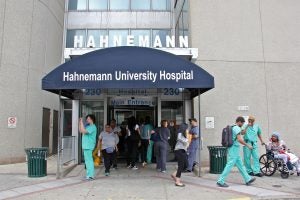Hahnemann plans to transfer most medical residents to Tower Health hospitals
Drexel College of Medicine and Hahnemann Hospital announced a shift of most residency programs to Philly region facilities managed by Tower Health.

Hahnemann University Hospital. (Emma Lee/WHYY)
Updated 5:40 p.m.
Hahnemann University Hospital announced Wednesday morning its plans to transfer the majority of its medical residency and fellowship programs to hospitals operated by Tower Health. The doctors are employed by Hahnemann but receive training through Drexel University’s College of Medicine. Tower, Drexel and Hahnemann all signed off on the plan.
When Hahnemann’s closure was announced at the end of June, the more than 550 doctors in training were left in the dark as to how they would proceed. Many had just moved to the city to begin a new academic year on July 1; others had established lives here. In a statement, Hahnemann, Drexel and Tower Health said this plan would result in “as little disruption as possible to the residents and fellows’ personal lives at a time when they are tasked with rigorous training.”
Tower is offering Hahnemann $7.5 million for the residency slots and the corresponding state certification that comes with being a teaching hospital, according to filings in U.S. Bankruptcy Court in Wilmington. Permission to do this must be granted by the judge because it goes against the standard procedure of bankruptcy order.
Medical residents are paid through federal funding distributed by Medicare. In the event that their training is disrupted and they need to switch placements, which is rare, their accepting institutions must receive the funding attached to the residents from the former employer. As of now, Hahnemann has not released the residents’ funding, but it said in a statement it would do so once it confirmed the cap value for every participant in the training program.
Tower Health will also seek to hire the faculty overseeing the residents in each program area.
Tower has six hospitals in the region, many in the Philadelphia suburbs: Brandywine Hospital in Coatesville; Chestnut Hill Hospital in Philadelphia; Jennersville Hospital in West Grove; Phoenixville Hospital in Phoenixville; Pottstown Hospital in Pottstown; and Reading Hospital in West Reading.
Drexel and Tower have an existing partnership. Earlier this year, the two announced a 20-year academic relationship between Drexel’s College of Medicine and Tower Health, along with plans to open a medical campus at Tower’s Reading Hospital. That is not slated to open until 2021.
No details were released regarding which medical programs would be transferred to which hospitals. Even before Wednesday’s announcement, the uncertainty worried some people.
“Programs are the size they are because of education as well as caring for patients,” said William Pinsky, president and CEO of the Educational Commission for Foreign Medical Graduates. “Any significant change to that number can potentially disrupt their activity and the quality of the program.”
Upon learning of the planned transfer of resident placements, Pinsky’s reaction was mixed.
“It’s a positive sign that people are talking and cooperating, but we’re not at the checkered flag yet,” he said. “It’s unclear whether Tower has the capability to expand its [graduate medical education] program to accommodate the large number of residents as well as the range of programs.”
For the move to be approved, the Centers for Medicaid and Medicare Services (CMS) would need to approve the transfer of slots. Right now, Tower Health has 118 Medicare-funded residency slots. Hahnemann had 570.
“The question is does Tower Health have enough patients, enough faculty, to support this quintupling of their training program,” said Janis Orlowski, chief health care officer at the Association of American Medical Colleges.
As a general rule of thumb, CMS gives hospitals between $100,000 and $150,000 annually to cover each resident. About 30% to 40% of that goes to residents’ salaries; the remainder goes toward programming and infrastructure that would support the hospital they work in to make it a successful teaching hospital.
That, plus the $7.5 million Hahnemann is offering Tower for the placements, means it’s possible that Tower would build out its programs to support the new residents over time. But, Orlowski said, that is unlikely to happen overnight.
Medical residents will not be forced to go to Tower Health hospitals if they seek their own placements. The Accreditation Council for Graduate Medical Education, which must approve the academic placements for residents, had already worked to secure more than 900 spots throughout the country for orphaned Hahnemann residents. Each new placement for residents must be up to ACGME standards.
ACGME did not comment Wednesday on what the process would be to accredit Tower, but said it “continues to demand that Hahnemann honor its policy to allow residents and fellows to choose where they would like to continue their graduate medical education.” The agency had already been scheduled to visit Hahnemann Friday to review the standards there.
Hahnemann, Drexel College of Medicine and Tower Health submitted their letter of intent to transfer the residents on the day before the first hearing on Hahnemann’s bankruptcy petition, scheduled for Thursday afternoon.
—
This article was updated to clarify details of the residents-transfer plan.
WHYY is your source for fact-based, in-depth journalism and information. As a nonprofit organization, we rely on financial support from readers like you. Please give today.






